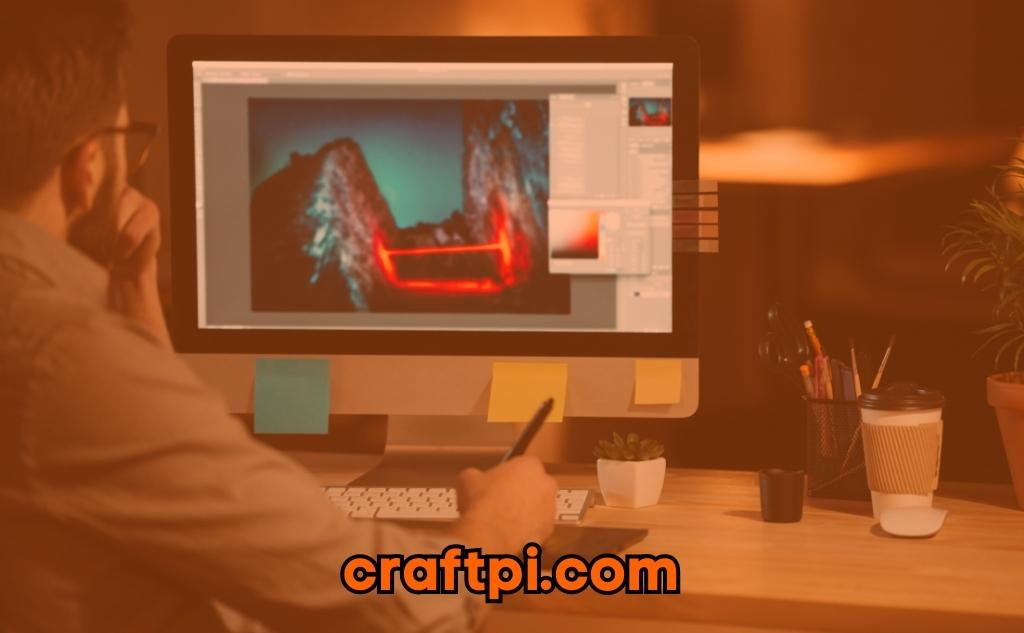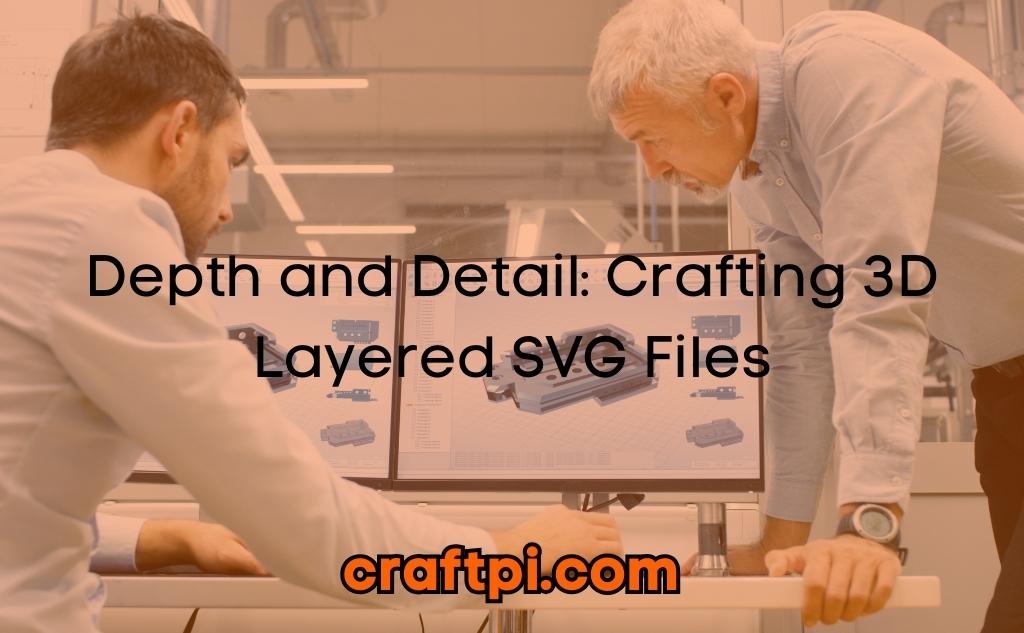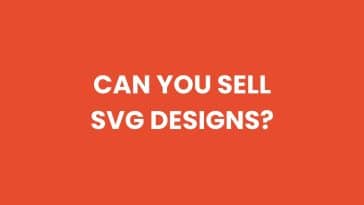Are you ready to take your design skills to the next level with 3D layered SVG files? In this blog post, we’ll explore everything you need to know about creating stunning 3D designs using SVG files. From understanding the basics of 3D layered files to choosing the right design software, creating depth with basic layers, adding intricate details with advanced techniques, and effectively using shadows and lighting, we’ll cover it all. We’ll also discuss how to optimize your SVG files for web and print, as well as explore the creative applications of 3D layered SVGs. Get ready to unleash your creativity and dive into the world of 3D design!

Understanding 3D Layered Svg Files
When it comes to creating visually stunning designs, 3D layered SVG files can take your project to the next level. These files consist of multiple layers stacked on top of each other to create a three-dimensional effect. However, understanding how to make 3D layered SVG files can be a bit daunting for beginners. In this blog post, we will explore the ins and outs of creating these files and provide you with valuable tips and techniques to master this art.
First and foremost, it is crucial to choose the right design software that supports 3D capabilities. Adobe Illustrator, Inkscape, and CorelDRAW are popular choices among designers. These software programs offer a wide range of tools and features to help you create intricate and detailed 3D designs. Familiarize yourself with the software’s user interface and learn how to navigate through the various options.
Creating basic layers for depth is the foundation of 3D layered SVG files. Start by designing the background layer, which sets the overall mood and ambiance of your artwork. Next, add foreground layers that gradually increase in size or complexity. This gradual layering creates an illusion of depth and dimension. Remember to organize your layers accordingly, making it easier to edit and modify later on.
- Utilizing Shadows And Lighting Effectively
- Optimizing Svg Files For Web And Print
- Exploring Creative Applications With 3D Layered Svgs
| File Format | Pros | Cons |
|---|---|---|
| .SVG | Scalable and compatible with different software programs | May be larger in file size compared to other formats |
| .PNG | Supports transparent backgrounds | Loses some level of scalability |
| .JPEG | Small file size, suitable for web applications | Lossy compression affects image quality |
While creating 3D layered SVG files, it is essential to experiment with shadows and lighting to add depth and realism to your artwork. Play around with the opacity, direction, and intensity of shadows. Incorporating highlights and gradients can further enhance the overall visual effect. Effective use of shadows and lighting can make your design appear lifelike and captivating.
Another crucial aspect is optimizing SVG files for web and print. SVG files are known for their scalability, but large file sizes can negatively impact loading times on websites and consume more resources. Reduce file sizes by compressing elements within the SVG and removing unnecessary details. By doing so, you can strike a balance between visual quality and performance, ensuring your 3D layered SVG files are suitable for various applications.
Last but not least, exploring creative applications with 3D layered SVGs opens up a world of possibilities. From creating intricate papercraft designs and unique signage to adding depth to illustrations and animations, 3D layered SVGs allow you to push the boundaries of your creativity. Experiment with different techniques, materials, and styles to unlock the full potential of 3D layered SVG files.
Choosing The Right Design Software
When it comes to creating 3D layered SVG files, choosing the right design software is crucial. While there are many software options available, not all of them are suitable for this specific task. In this blog post, we will explore the key factors to consider when selecting the best design software for your needs.
Firstly, it is important to choose a software that supports the creation of 3D objects and layers. This feature is essential for producing intricate and visually appealing designs. Look for software that offers a wide range of 3D tools and functions, such as the ability to extrude, rotate, and manipulate objects in three dimensions.
Additionally, compatibility with SVG file formats is another crucial aspect to consider. SVG (Scalable Vector Graphics) files are widely used for web and print designs due to their ability to scale without losing quality. Ensure that the design software you choose allows you to save and export files in SVG format, as this will make it easier to work with other applications and devices.
- Next, consider the learning curve associated with the design software. Some programs may have a steeper learning curve than others, requiring more time and effort to become proficient. If you are new to 3D design, it may be beneficial to choose a software with user-friendly interfaces and extensive documentation or tutorials available.
- Another important factor to consider is the software’s rendering capabilities. The way a design software renders 3D layers can significantly impact the final result. Look for a software that provides high-quality rendering, with smooth shading and realistic shadow effects.
| Software | 3D Functionality | SVG Compatibility | Learning Curve | Rendering Quality |
|---|---|---|---|---|
| Software A | Excellent | Good | Medium | High |
| Software B | Good | Excellent | Low | Medium |
| Software C | Excellent | Excellent | High | High |
Lastly, consider your budget and the cost of the design software. Some software options may be more expensive than others, but they might also offer advanced features and functionalities. Assess your design needs and budget to make an informed decision.
In conclusion, choosing the right design software is essential for creating stunning and intricate 3D layered SVG files. Consider factors such as 3D functionality, SVG compatibility, learning curve, rendering quality, and budget when making your decision. By carefully evaluating these aspects, you can select a software that best suits your specific needs and preferences.
Creating Basic Layers For Depth
When it comes to creating 3D layered SVG files, one of the key aspects to consider is how to create basic layers for depth. By adding layers to your design, you can give it a three-dimensional feel, making it more visually appealing and realistic. In this blog post, we will explore different techniques and tips on how to effectively create basic layers for depth in your 3D layered SVG files.
One of the first steps in creating basic layers for depth is to understand the concept of foreground, middle ground, and background. These three elements play a crucial role in creating depth and adding dimension to your design. The foreground represents the objects or elements that are closest to the viewer, while the background refers to the elements that are farthest away. The middle ground acts as a transitional layer between the foreground and the background.
To create basic layers for depth, you can start by outlining the different objects or elements in your design. By separating them into individual layers, you can easily manipulate and arrange them to create a sense of depth. You can use design software such as Adobe Illustrator or Inkscape to create separate layers for each element. Once the layers are created, you can position them accordingly based on their placement in the foreground, middle ground, or background.
- Layering Techniques: Experiment with different layering techniques to enhance the depth and dimension in your 3D layered SVG files. You can achieve this by altering the size, opacity, and position of each layer. By placing smaller objects in the foreground and larger objects in the background, you can create a sense of distance. Adjusting the opacity of each layer can also help to create a subtle transition between the different layers.
- Color and Gradient: Another effective way to create basic layers for depth is by using color and gradients. Use lighter and brighter colors for the objects in the foreground and gradually transition to darker and duller shades for the objects in the background. This technique helps to create an illusion of depth and adds visual interest to your design.
- Texture and Shadow: Adding texture and shadows to your design can also contribute to creating basic layers for depth. By applying texture to the foreground elements and gradually reducing it in the background, you can simulate the effect of distance. Additionally, incorporating shadows beneath the objects can help to create a sense of depth and realism.
| Software | Pros | Cons |
|---|---|---|
| Adobe Illustrator | Offers advanced design tools and features | Requires a subscription or purchase of the software |
| Inkscape | Free and open-source software | May have a steeper learning curve for beginners |
By utilizing these techniques and tips, you can create basic layers for depth in your 3D layered SVG files. Remember to experiment, improvise, and refine your designs to achieve the desired depth and realistic effect. Creating layers for depth not only enhances the visual appeal of your designs but also adds a sense of realism and dimension.

Adding Detail With Advanced Techniques
In order to take your 3D layered SVG files to the next level, it is essential to learn advanced techniques that will add intricate detail and enhance the overall visual appeal. These techniques allow you to create stunning designs that captivate the viewer’s attention and add depth to your artwork. By incorporating advanced methods into your designs, you can elevate your creations and make them truly stand out.
One method to add detail to your 3D layered SVG files is by utilizing gradient overlays. Gradients can be used to create smooth transitions between different colors, giving your design a more realistic and polished look. By applying gradients to individual layers or specific sections of your design, you can add depth and dimension, making elements appear more lifelike.
Another advanced technique that can enhance the detail of your 3D layered SVG files is the use of texture overlays. Textures can be applied to different layers or elements within your design to create a sense of tactile quality. Whether it’s adding a wood grain texture to a wooden object or a metallic texture to a metal surface, textures can make your design visually engaging and bring it to life.
| Benefits of Adding Detail with Advanced Techniques | |
|---|---|
| 1. Enhanced Realism: | Advanced techniques such as gradient overlays and texture overlays contribute to a more realistic appearance, making your 3D layered SVG files visually convincing. |
| 2. Increased Visual Interest: | By incorporating advanced techniques, you can add intricate details that catch the viewer’s attention and make your designs more visually appealing. |
| 3. Improved Depth and Dimension: | These techniques allow you to create depth and dimension within your designs, making them appear more three-dimensional and captivating. |
Furthermore, advanced techniques like the use of transparency and blending modes can also contribute to adding detail to your 3D layered SVG files. By adjusting the opacity and blending modes of different layers or elements, you can create unique effects and combine elements seamlessly, resulting in a more intricate and visually compelling design.
When adding detail with advanced techniques, it is vital to strike a balance. While it’s tempting to incorporate numerous details, overcrowding your design can lead to visual clutter and confusion. Therefore, it’s essential to consider the overall composition and ensure that the added details contribute to the overall aesthetic appeal of your 3D layered SVG files.
By incorporating advanced techniques such as gradient overlays, texture overlays, transparency, and blending modes, you can elevate the level of detail in your 3D layered SVG files. These techniques allow you to create visually stunning designs that captivate the viewer’s attention with their intricate details and impressive depth. Experimenting with different techniques and finding the right balance of detail will ensure that your 3D layered SVG files stand out and leave a lasting impression.
Utilizing Shadows And Lighting Effectively
When it comes to creating 3D layered SVG files, one important aspect to consider is the effective utilization of shadows and lighting. Shadows and lighting play a crucial role in adding depth, realism, and visual interest to your designs. Understanding how to use these elements effectively can elevate your 3D layered SVGs to a whole new level.
One of the key techniques for utilizing shadows and lighting in 3D layered SVG files is to pay attention to the direction of light source. To create a realistic effect, it is essential to determine the position of the light source in your design and cast shadows accordingly. This can be achieved by strategically placing shadows in the layers of your SVG file, emphasizing depth and adding dimensionality.
Another tip to effectively utilize shadows and lighting in 3D layered SVG files is to experiment with different shading techniques. By adjusting the intensity, angle, and color of the shadows, you can create various effects and moods in your design. Whether you want to convey a sense of drama, highlight specific elements, or simply enhance the overall appearance, playing with shadows and lighting can help you achieve the desired outcome.
| Benefits of Utilizing Shadows and Lighting |
|---|
| Increase realism and depth Enhance visual interest Create a sense of drama or mood Highlight specific elements Add dimensionality to the design |
Moreover, it is important to consider the target platform or medium for your 3D layered SVG files. Shadows and lighting may appear differently in print compared to web or digital platforms. Therefore, optimizing your SVG files for the specific platform can ensure the effective utilization of shadows and lighting. Adjusting the colors, contrast, and transparency levels can help maintain the intended visual impact across different mediums.
In conclusion, shadows and lighting are powerful tools for creating visually compelling 3D layered SVG files. Understanding the direction of the light source, experimenting with shading techniques, and optimizing for different platforms are crucial steps in utilizing shadows and lighting effectively. By mastering these techniques, you can bring depth, realism, and captivating visual effects to your designs.
Optimizing Svg Files For Web And Print
Optimizing SVG Files for Web and Print
SVG files are popular in both web and print design due to their scalability and ability to maintain high-quality graphics. However, to ensure optimal performance and compatibility, it is essential to optimize SVG files for their intended use. In this blog post, we will explore various techniques and best practices for optimizing SVG files for both web and print applications.
Reducing File Size
One of the key considerations when optimizing SVG files is reducing their file size. Smaller file sizes not only result in faster loading times but also ensure compatibility with different platforms and devices. To achieve this, consider the following techniques:
- Remove unnecessary elements: SVG files often contain hidden or redundant elements that contribute to larger file sizes. By removing such elements, you can significantly reduce the file size while maintaining the overall design integrity.
- Simplify complex paths: Complex paths with excessive anchor points can contribute to larger file sizes. By simplifying these paths without compromising the design, you can effectively reduce the file size.
- Apply compression: Utilize compression techniques such as gzip to further reduce the file size. This can be achieved by configuring the server to automatically compress SVG files before sending them to the client’s browser.
Ensuring Scalability
Another crucial aspect of optimizing SVG files is ensuring their scalability. As SVG files are resolution-independent, they can be scaled to any size without sacrificing quality. To achieve optimal scalability:
- Use vector graphics: Unlike raster formats, SVG uses mathematical formulas to render images, resulting in smooth curves and sharp lines when scaled. By using vector graphics, you can maintain the design’s integrity across different dimensions.
- Specify dimensions: While SVG files are scalable, it is still recommended to specify width and height attributes to provide guidance to browsers and maintain consistency across devices.
Optimizing for Web
When optimizing SVG files for web applications, consider the following techniques:
- Minify the code: Removing unnecessary spaces, line breaks, and comments from the SVG code can significantly reduce the file size, leading to faster load times.
- Externalize CSS: If your SVG file includes inline CSS, consider moving it to an external style sheet. This allows the SVG file to be cached separately and can improve loading times.
Optimizing for Print
Print applications often require higher resolution and precision. To optimize SVG files for print:
- Set appropriate DPI: Determine the required resolution (Dots Per Inch) for the print output and set the SVG file’s dimensions accordingly. This ensures that the image appears crisp and clear in the final print.
- Embed fonts: If your SVG file uses custom fonts, ensure they are embedded properly to maintain the design’s integrity when printing on different systems.
In conclusion, optimizing SVG files for web and print applications is crucial for ensuring fast loading times, compatibility, and high-quality output. By implementing the techniques discussed in this blog post, you can effectively optimize your SVG files for their intended use and enhance the overall user experience.
Exploring Creative Applications With 3D Layered Svgs
In recent years, the use of 3D layered SVG files has gained popularity among artists, designers, and hobbyists alike. These versatile files allow for the creation of stunning and intricate designs that can be used in a variety of creative applications. Whether you are a graphic designer looking to add depth to your illustrations or a DIY enthusiast wanting to create unique pieces, understanding how to make 3D layered SVG files is essential.
One of the first steps in creating 3D layered SVG files is choosing the right design software. There are several options available, each with its own strengths and weaknesses. Adobe Illustrator is a popular choice among graphic designers due to its powerful vector editing capabilities. Alternatively, Inkscape, a free and open-source software, offers similar functionality and is a great option for beginners or those on a budget. Whichever software you choose, it is important to familiarize yourself with its tools and features to effectively create and manipulate layered designs.
Once you have chosen the design software, creating the basic layers for depth is the next important step. This involves breaking down the design into separate layers, each representing a different element or section of the overall composition. For example, if you are creating a 3D layered SVG of a flower, you may have separate layers for the petals, stem, and leaves. By organizing the design in this way, you can easily manipulate each layer individually to achieve the desired depth and dimension.
Adding detail to your 3D layered SVG files can be accomplished using various advanced techniques. One popular method is the use of gradients and gradients meshes to create realistic shading and highlights. By carefully applying these techniques to specific layers, you can enhance the overall depth and visual impact of the design. Additionally, incorporating textures, patterns, and intricate shapes into different layers can further enhance the detail and complexity of the final piece. Creating depth and dimension in 3D layered SVGs can also be achieved through effectively utilizing shadows and lighting. By strategically placing shadows and highlights on different layers, you can create a sense of depth and realism. For example, by adding a drop shadow to a layer representing a raised object, you can visually separate it from the background and make it appear more three-dimensional. Similarly, using a combination of soft and harsh lighting effects can further enhance the illusion of depth and add visual interest to your design.
| Optimizing Svg Files For Web And Print |
|---|
| Once you have created your 3D layered SVG files, it is important to optimize them for web and print usage. This involves reducing file size without compromising on quality. One way to achieve this is by simplifying complex shapes and removing unnecessary detail. Additionally, using appropriate file formats, such as SVG or PNG, can help maintain the integrity of the design while ensuring compatibility and crisp resolution. Lastly, properly naming and organizing the layers within the SVG file can make it easier to work with and modify in the future. |
Frequently Asked Questions
What are 3D layered SVG files and how can they be used?
3D layered SVG files are digital graphics that contain multiple layers to create the illusion of depth. They can be used in various creative applications such as web design, print media, and animation.
What factors should be considered when choosing the right design software for creating 3D layered SVG files?
When selecting design software for creating 3D layered SVG files, it is important to consider factors such as the software’s compatibility with SVG file formats, its 3D design capabilities, and its user-friendly interface for efficient workflow.
How can basic layers be created to achieve depth in 3D layered SVG files?
Creating basic layers for depth in 3D layered SVG files involves using various design techniques such as overlapping shapes, applying gradients or shading, and adjusting the size and placement of objects to create a sense of depth.
What advanced techniques can be used to add detail to 3D layered SVG files?
Advanced techniques for adding detail to 3D layered SVG files may include using texture overlays, applying intricate patterns or textures to individual layers, and incorporating effects such as embossing or engraving to enhance visual interest.
How can shadows and lighting be effectively utilized in 3D layered SVG files?
Shadows and lighting can be effectively utilized in 3D layered SVG files by strategically placing light sources, applying shadows to create depth and realism, and using lighting effects to highlight specific areas and add dimension to the design.
How can SVG files be optimized for web and print usage?
To optimize SVG files for web and print usage, it is important to minimize file size by removing unnecessary metadata, compressing the file without sacrificing quality, and ensuring compatibility with different browsers and printing processes.
What are some creative applications of 3D layered SVG files?
3D layered SVG files can be creatively used in various applications such as interactive web animations, product packaging designs, architectural visualizations, game development, and creating 3D illustrations for books or magazines.




 No products in the cart.
No products in the cart.